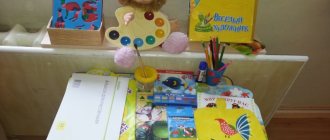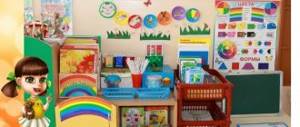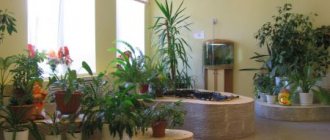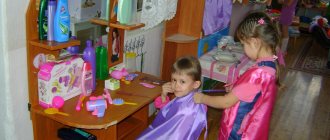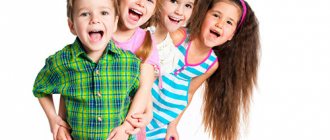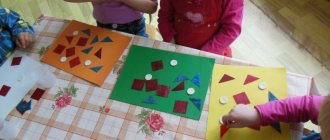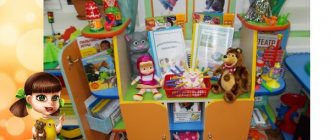Requirements for the design of a corner according to the Federal State Educational Standard
Requirements are made for corners in accordance with their theme, however, general provisions are highlighted for all children's activity centers in kindergarten:
- meeting the interests of children;
- filling the material base taking into account the age characteristics of pupils;
- aesthetics, attractiveness and comfort - to create a good mood;
- convenience and accessibility of corner materials for every child;
- optimal location in the group room (relative to the light source, other thematic corners);
- taking into account the regional component when designing a corner (for acquaintance and study of national life, art, crafts and crafts, language, literature).
Corners should be attractive and accessible to children and have an optimal location relative to each other and the light source
Passport for a corner in kindergarten
For each corner, a group passport is filled out and stored in a protective pocket directly in the activity center or in the teacher’s document folder.
The passport describes the data and the following characteristics of the corner:
- name of the corner;
- group number, age of children;
- goals and objectives of the corner;
- pieces of furniture, their quantity;
- materials and tools, their quantity;
- visual materials (wall posters, maps, diagrams);
- card index of games, exercises, experiments (possible in the corner).
The corner’s passport contains information about material equipment and examples of activities
Corners in kindergarten: orientation, content, functioning
| Focus | Corner name | Equipment, material resources | Operation |
| Cognitive and research | Corner of educational research/experimental activities | Natural materials; samples of fabrics, metals, wood, plastics; substances; glass and plastic vessels and containers; medical materials; instruments and tools for practical research; protective gowns, caps, gloves; card index of experiences and experiments; wall diagrams; forms for recording research results. | Conducting research on the properties of various objects in independent or joint experimentation with a teacher. |
| Sensory Corner | Large plastic containers with water and sand (if possible, including kinetic sand); play sets for activities with these materials; natural materials and other items for experimenting with water and sand (plastic cubes, wooden balls, nut shells, etc.). | Experimental games for preschool children. | |
| Corner "Space" | Functional models (lunar rover, space rocket); layouts (“Solar System”, “Black Hole”, “Milky Way”); illustrated encyclopedias; photo collages and posters on the theme “Space”; materials for experiments and modeling. | Conducting simulation experiments (partial and total solar eclipses, rotation of planets around the Sun and their axis, satellites of planets). | |
| Corner of the future | Functional models (robots, automated technology); photographic materials of the latest scientific developments; materials for modeling and design. | Introduction to robotics, master classes. | |
| Gaming | Corners of role-playing games: “Hairdresser”, “Hospital”, “Shop”, “Post Office”, “Beauty Salon”, “Railroad”, “Kitchen”, “Mothers and Daughters”, “Space”, “Garage” | Sets of items and costumes for the game; list of options for playing the game. | Independent play activities for children aged 4–7 years. |
| Play corner for girls/boys | Toys, costumes for role-playing games, taking into account the interests of girls and boys. | ||
| Play activity corner | Dolls; toys made of various materials (plush, plastic, wood); Board games; construction kits; card index of didactic games. | For children 1.5–3 years old: object-based activities with toys, didactic games together with the teacher. For children 4–5 years old: role-playing and board games according to the rules proposed by the teacher. For children 6–7 years old: independent games. | |
| Speech | Reading corner, book/library corner, fairy tale corner | A selection of books and magazines in accordance with the age of children and their interests; decorating a corner with illustrations; toys-book characters (heroes of fairy tales, Cheburashka, Moidodyr, Carlson, etc.). | Listening to literary texts, conducting educational conversations based on books read, independent study of printed publications, learning poems. |
| Speech therapy corner | Pictures for articulation gymnastics; board games to automate sounds; cards with subject images on various lexical topics; card index of didactic games. | Joint classes with the teacher to improve the purity of pronunciation of sounds and the development of phonemic hearing. | |
| Motor | Physical education/sports corner | Sports equipment (balls, hoops, jump ropes, skittles, etc.); illustrative materials on summer and winter sports, team and individual, Olympic; card index of thematic physical education minutes; list of outdoor games. | Organization of mini-competitions for dexterity by the teacher; conducting finger gymnastics, exercises, dance breaks; independent outdoor games and exercises. |
| Artistic, creative | Artistic and aesthetic corner | Reproductions of paintings, reduced copies of architectural and sculptural objects; tools and materials for practical activities: white paper and cardboard, a set of colored and corrugated paper, plasticine, paints (watercolor, gouache), pencils, brushes, scissors, glue, accessories and natural material for decorating crafts; a collection of tasks for productive creativity, craft options; technocards for modeling and origami. | Studying visual material and conducting heuristic conversations; creating crafts using various techniques: drawing, modeling, appliqué, plasticineography, origami. |
| Corner "Folk Crafts" | Toys, dishes and interior items in folk style (Gzhel, Khokhloma, Zhostovo, Dymkovo and Kargopol toys, Skopin ceramics, etc.); illustrated books on folk arts and crafts; materials for children's productive creativity; algorithm for sculpting folk toys, patterns for creating patterns. | Studying exhibitions of folk crafts, creating crafts in folk style. | |
| Theater corner, dressing up corner | Decorations for fairy tales; sets of puppet and finger theaters; masks and character costumes for children, wigs; face painting; card index of dramatization games. | Acting out dialogues of fairy-tale characters, preparing a performance for a leisure event. | |
| Music corner | Player and collection of audio recordings (children's, holiday songs, recordings of sounds and voices of nature with instrumental accompaniment); portraits of composers; instruments: rattles, rattles, xylophone, spoons, bells, pipes, whistles, drum, balalaika, tambourine; card index of music/dance games. | Joint and independent creative activities with the teacher (orchestra games, concerts); listening to audio recordings and discussing experienced emotions. | |
| Moral education | Good deeds corner | Wall newspapers and posters about helping your neighbor and treating animals kindly; books on this topic; lapbooks and photo albums with examples of good deeds of students. | Conducting conversations to discuss students’ personal experiences, stories read, and jointly designing wall newspapers. |
| Orthodox corner, Easter corner, Christmas corner | Visual Orthodox calendar; illustrated edition of the Bible for children; figurines and pictures depicting angels, churches; decorative Easter eggs; models “Nativity Nativity Scene”, “Gifts of the Magi”, “Entrance of the Lord into Jerusalem”. | Reading and discussion of biblical stories translated for children; preparation for holiday leisure activities in a group (Christmas, Easter, Honey Spas, Trinity, Intercession). | |
| Corner "Family" | Illustrations on family themes; examples of family tree design; selection of printed publications; game sets and figures. | Conversations aimed at developing family values; research and creative activities to compile the history of the family. | |
| Patriotic education | Hometown Corner | Photographic material of sights and interesting places in the city; coat of arms and anthem of the city; layout of the main street; children's drawings on the theme “My yard”, “My street”, “Holiday in our city”. | Discussion of important events in the life of the city, preparation for participation in the celebration of City Day. |
| National corner | Exhibition of dolls in national costumes, utensils and crafts; books in the national language. | Listening and discussing national fairy tales, learning poems and songs in their native language. | |
| Labor education | Labor corner, housekeeping corner, attendants' corner, washbasin corner | Posters-algorithms for performing the procedure for self-service and completing orders; motivational pictures and the importance of work; aprons, scarves, sleeves, gloves (for cleaning, duty in the dining room and nature corner). | Conversations with the teacher about the importance of work, hygiene rules; preparation for collective participation in general cleaning, planting trees and flowers on the territory of the preschool educational institution. |
| Development of social competencies | Professions Corner, Doctor's Corner, Railway Worker's Corner | Books about professions; photographs of people at work (opportunities, parents of students); game themed sets “Doctor”, “Policeman”, “Fireman”, “Builder”, “Cook”, etc.; card index of didactic games on the topic “Professions”. | Heuristic conversations, children's speech on the topic “What do my parents do?” |
| Transport corner, traffic rules corner | Books about rules of conduct on the road (including the railway); traffic rules posters; layout of the roadway; board and educational games. | Discussion and repetition of safety rules on the roadway, watching educational cartoons, participating in games that simulate road flow and the actions of pedestrians. | |
| Creating Positive Motivation | Corner of forgotten things, corner of lost things | Funny designed containers with lost things (toys, mittens, socks, etc.). | This is where the guys bring the unwanted items they find and look in if they themselves have lost something. |
| Birthday corner | A festively decorated congratulatory stand with a window for a photo of the birthday person. | Congratulations to the birthday person, singing songs (“Let them run clumsily”, “Happy Birthday to you”), playing a game (“Loaf-loaf”, for example), presenting a gift, wishes. | |
| Food Corner | Wall newspaper about the work of the canteen in the preschool educational institution; photographs of kindergarten cooks; menu for the week. | Conducting conversations about healthy eating and eating habits, food intake rules. | |
| Teacher's Corner | Photos of the teacher at work, with students; certificates for teaching achievements. | Discussion of the importance of the work of educators, additional education teachers, and teachers. | |
| Achievement Corner | A stand with diplomas and certificates of students, photographic materials from project presentations, creative and sports competitions. | Congratulations to the competition winners. | |
| Corners of additional education | First-grader's corner | Workplace (desk and chairs); school supplies: briefcase, pencil case with hands, pencils, ruler, etc., preparation kit, notebooks, textbooks for first grade; printouts with tasks for determining the sound composition of a word, writing printed letters, addition and subtraction within 10; illustrations on the theme “Knowledge Day”, “First grade”, a set for playing school. | Independent research activities, conducting exercises to prepare for learning to read and write, conducting a conversation about school: the first teacher, lessons and holidays, the school day routine, school uniform. |
| English Corner | Posters with letters of the English alphabet, illustrated words; player and selection of audio recordings (songs, poems, phonological exercises in English); game file. | Joint activities with the teacher to study letters, words and construct dialogues in English, learning songs and poems. | |
| Chess corner | Collection of chess sets in various styles (wooden, magnetic, cardboard, etc.); cards with rules for moving figures and their names; card index of chess problems for children. | Teaching basic chess skills; problem solving and independent games for children who play chess (attend a club). | |
| Communication | Courtesy corner, etiquette corner, “Hello, I’m here!” (welcome corner) | Game sets for acting out dialogues, reminder posters of polite words, a card index of didactic games. | Teaching the rules of polite communication and etiquette in a playful way. |
Creating a speech environment in the junior group
Elena Podkopaeva
Creating a speech environment in the junior group
«Creating a speech environment in the junior group.»
“A child will not speak in empty walls”
E. I. Tikheyeva.
Good speech is the most important condition for the comprehensive development of children. The richer and more correct a child’s speech, the easier it is for him to express his thoughts, the wider his opportunities for understanding the surrounding reality, the more meaningful and fulfilling his relationships with peers and adults, the more active his development is.
In preschool pedagogical science, the speech environment is understood not only as the subject environment; it is important that the speech environment is organized most effectively in order to influence the development of different aspects of each child’s speech.
The development of a preschool child is most successfully carried out in an enriched developmental environment , which provides a variety of activities and enriches the speech experience of children .
Therefore, the creation of a speech environment is the most important direction for improving the quality of work on the development of speech in preschool children.
The goal of building a speech environment is to saturate the environment with components that ensure the development of speech of a preschool child.
Creating a speech environment in the junior group “Bunny”
It starts from the reception area, where we meet our kids. We found our place in the reception area:
Information corners for parents;
Crafts (creative works)
children;
Mood Corner;
"Miracle Tree"
.
All this creates a comfortable mood and contributes to the emotional well-being of children.
I would like to pay special attention to the role of routine moments in creating an active speech environment , since the encouragement for speech activity , the formation of children’s speech by teachers occurs in the process of live communication with the child.
Our group has such development environments as :
Center for role-playing games - helps to form in children the foundations of a culture of communication through solving problem situations. The necessary conditions have been created for the development of the game in : we equipped the children’s play area with furniture, brought in various attributes, dolls, sets of dishes, cribs, strollers, cars, construction sets and much more for the game “Family”
,
“Shop”
,
“Hairdresser”
,
“Hospital”
,
“Builders”
,
“Car Park”
,
“Library”
,
“Theatre”
,
“House of Solitude”
.
Center for sensory development - in this corner we have games with small objects: mosaics, puzzles, beads, construction sets, etc., lacing games (various types, games with clothespins, dry pool, pyramids, cubes, finger games, board-printed games , inserts of different shapes, nesting dolls with inserts, “wonderful bag”
, sensory pillows, sensory panels with various fasteners, lacing, Velcro, plugs, etc.
Center for artistic creativity - here children draw and sculpt in their free time, thereby developing fine motor skills and imagination.
Center for speech development - it includes: a book corner - where they read their favorite fairy tales and look at plot pictures, a theatrical corner with various types of theater, a universal, multifunctional cabinet, a finger theater, fairy tale puzzles, matryoshka fairy tales, doll mittens, flannelgraph, "queen book"
,
“
speech yard ” , masks, story pictures and educational games.
Our group has a card index , it includes a complex of articular gymnastics in pictures, routine moments, rules of conduct in kindergarten, active and round dance games, nursery rhymes, subject-based plot pictures for composing descriptive stories, games for speech development , games for vocabulary development, mnemonics, traffic rules, etc.
Decorating a corner with your own hands
The children's activity corner should be cozy and pleasant for the pupils to be in. The colorful design, the use of plots and characters familiar to children, and the addition of stickers and drawings to the shelves evoke positive emotions.
Elements of the teacher’s independent design of children’s corners with the involvement (optional) of parents and students themselves:
- drawing thematic wall newspapers and posters;
- creating simple decorations: origami figures, kusudama, paper flowers, snowflakes, butterflies and lanterns;
- creating a corner in the style of a literary work or cartoon;
- decoration with natural materials: bouquets of dried flowers, baskets and boxes of twigs, figurines of acorns;
- execution of layouts: “Our Street”, “Railway”, “Volcano”, “Solar System”, “Island Structure”, “Jungle”, “Christmas”, etc.;
- preparation of mini-exhibitions from the works of students;
- production of puppets for finger and shadow theater, masks;
- drawing scenery for gaming and theatrical activities;
- development of tasks for didactic games: cutting out cards and chips, ruling forms, etc.
An option for decorating corners using hand-made images of characters familiar to children - fairy-tale gnomes
Subject-based development environment in the 1st junior group of kindergarten
One of the determining factors in raising children is the subject-development environment. We present to your attention our version of a development environment.
All centers of the developmental environment in our group are interconnected and united by tasks implemented in the updated program edited by M.A. Vasilyeva:
- Satisfy the baby's need for movement;
- Form a positive emotional attitude;
- Encourage children to speak actively.
During early childhood, a small person actively learns about the world around him. And our task is to make the child’s environment bright, interesting, memorable, emotional, active, and mobile. A properly organized subject-development environment helps an adult ensure the harmonious development of the child, create an emotionally positive atmosphere in the group, organize and conduct games and activities, and thus accustom children to independent games with gradually more complex content.
Physical activity zone
The need for movement is an important task when organizing a subject-development environment. In the "Motor Activity Zone"
there is a “health track”, massage mats, balls, gymnastic sticks, hoops, throwing balls, rings, attributes for outdoor games, as well as aids necessary for morning exercises and awakening exercises - flags, rattles.
In the area of play propulsion modules, technical toys are collected: cars - dump trucks, trucks (children can easily roll dolls, soft toys in them, and transport construction parts); cars, wheelchairs, strollers. There is also play building material of different sizes in primary colors for constructing buildings and toys for playing with.
Game
The main activity of our kids is play. In our
toys have been collected that introduce children to the everyday objects around them. Kids not only get acquainted with objects that are new to them, but also learn to act with them. And then they transfer the acquired knowledge and skills into everyday life.
Since I am conducting experience in sensory work, in the “Living Room” there are sets of dishes in primary colors, I knitted handbags in primary colors, and in the dressing room I sewed multi-colored skirts with headbands.
helps the teacher in amateur play - experimenting with various objects and natural materials. By organizing games with sand and water, the teacher not only introduces children to the properties of various objects and materials, but also reinforces basic ideas about the shape, size, color of objects, and develops the child’s fine motor skills.
Kids love these games. Sand can be poured from palm to palm, from a scoop into a mold, you can bury various objects in it and dig them out, build slides, paths, etc. Playing with water evokes positive emotions and promotes inner relaxation of the baby. The center is located so that children can approach it from all sides.
Didactic table
The educational table is part of educational games. I use it to conduct play-activities with a small group of children and individually to develop sensory abilities. I periodically change the occupancy of the teaching table, because the equipment of the teaching table is very mobile.
We purchased collapsible chairs with tools for the group for our boys. Kids acquire certain skills when operating with screwdrivers and a hammer.
Music and Theater Center
Children are delighted with our music and theater center
. There are musical instruments here that bring many joyful moments to children. And, in addition, they develop phonemic hearing and a sense of rhythm in the baby. We try to introduce children to various types of theater, so that each child can choose the theater that is closest and most convenient to him. Here we have a flannelgraph, table theater, finger theater and Bi-Ba-Bo dolls. Meeting with a doll helps children relax, relieve tension, and create a joyful atmosphere.
ISO corner
Early age is most favorable for the development of visual activity. Therefore, in the corner of visual activity
There are markers, crayons, pencil sets, stencils, plasticine, drawing paper, gouache and brushes.
Book corner
Since the development of active speech is the main task of children’s development, sets of subject pictures, sets of plot pictures, games on cognitive development and speech development are selected in the center of a favorite book
and speech development
. My kids love it when we read books and look at pictures with them, so we have a lot of books here according to the program.
Corner “My Family”
At an early age, children have a hard time being separated from their parents; our common goal is to help the child enter the life of kindergarten as painlessly as possible. “my family” corner was created for kids.
. Parents brought their family photos, and now children can look at the photo at any time and remember mom and dad. This helps ensure that the baby does not feel lonely or abandoned. While looking at the photographs, we talk with the children, question them, activating the children’s speech.
Center for educational games
The center for educational games is aimed at developing speech, sensory perception, fine motor skills, and imagination. Equipment: nesting dolls with inserts, inserts of different shapes, a set of sticks of different colors, lacing toys of different types, plot-didactic panels with buttons, buttons, different types of mosaics, lotto on different topics, printed board games, wall panel with geometric shapes.
A place for privacy
Children love a corner of solitude where they can read a book alone, sit with their favorite toy and just relax.
Changing room
I would like to talk a little about the design of the dressing room. There is a stand “Here we are” , where photos of children attending the group are posted. Children look at the photos and say the names of the children.
There is a corner for parents, a corner for an exhibition of children's art works, and a corner for modeling, where children's works are also exhibited.
All the toys and aids that surround the baby, to one degree or another, influence his development. All the corners presented to your attention constitute a subject-development environment.
Previous articles:
- Formation of emotional vocabulary in children
- Ideas for decorating a kindergarten
Approximate sketches and layouts of corners: photo gallery
Sketch of the design of the parent's corner: cells for current information, daily routine, demonstration of children's activities
Sketch of the design of a play corner: cells for information, a place for children's drawings and crafts
Sketch of the design of a creative corner: cells for information, a place for placing children's works
Sketch of a corner with hanging shelves, cells and tension threads for securing children's work
Layout of a corner for playing games “Kitchen”, “Washing”
Layout of a corner for organizing play activities, also suitable for educational, research and book corners
Layout of a corner for educational games with a retractable table
Book corner layout
Layout of the play area with soft modules
Tent layout for decorating a corner of privacy
